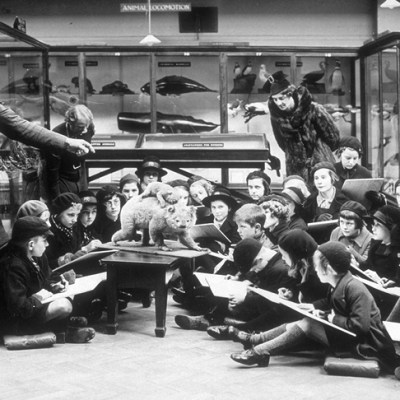At the height of summer, several weeks before the new football season is due to start, I find myself at the FC Barcelona Museum. The museum, which first opened in 1984, is attached to the side of the Camp Nou stadium, and was remodelled in 2010 across three floors – respectively supposed to represent Knowledge, Experience, and Emotion. Since then it has consistently been in the top three most-visited attractions in the city, just after the Sagrada Familia and Park Güell.
Barça’s story is richer and more idealistic than that of any other major European team, and the first floor does a good job of placing the emergence of the modern club in relation to Catalan politics and anti-fascist resistance during the Franco years, even if this sits rather awkwardly alongside the function of the museum as a branding platform for the global business that FC Barcelona has become. The club motto, ‘Més que un club’ (More than a Club), serves a kind of double duty here, both a declaration of commitment to progressive politics and a catchy advertising slogan for Nike. Appropriately, the motto and the Nike ‘swoosh’ are both picked out in yellow seats in adjacent stands of the stadium.
The texts and photographs are interspersed with objects. Here are the Adidas boots worn by Lionel Messi in the World Club Cup final in 2009; the boots worn by Andrés Iniesta and Ronald Koeman in major finals, now rather scruffy; and boots cast as terrifically ugly sculptures, awarded each year to the winner of the European ‘Golden Boot’, which, in the past decade, has more often than not been Messi. (In fact the boot has only a thin layer of gold electroplated over brass alloy.) Here are shirts worn by notable players throughout the club’s history. Here is a wall of trophies. Most of these artefacts are displayed in glass cases very brightly lit from below, which doesn’t encourage the visitor to linger very long over any one object – although in fairness, the cumulative effect of the trophy wall is to confirm that the sports trophy has not been one of the more interesting fields in recent design history.
On to the touchscreen wall (‘Experience’). This is less impressive today, perhaps, than when it was conceived more than 10 years ago. An archive of highlights can be summoned from the menus, and they whoosh up pleasingly on to the screen, but why would we want to watch Rivaldo’s golaço de bicicleta against Valencia now, in the museum, when we could have watched it on YouTube on our phones back in the hotel? (In other words, why have I dragged my wife here on our holiday?) Likewise, the room dedicated to Messi’s achievements falls rather flat, dominated as it is by more trophies, photographs of him – both the lank-haired youngster and the bearded and tattooed hipster he has become – and wall texts listing his career achievements. Here the museum heads in the direction of a hall of fame, which is perhaps what many visitors want, but is of limited interest when these photographs and statistics are freely available online.
On the next floor up, some artworks. Joan Miró’s poster, Futbol Club Barcelona, and a Salvador Dalí lithograph, Homenaje al FC Barcelona, both created for the 75th anniversary of the club in 1974, hang alongside a painting that Antoni Tàpies made for the club centenary in 1999. In each of them, familiar iconography – the club crest, a football boot – jostles with energetic freehand mark-making.
Entrance to the museum comes packaged in the ‘Camp Nou Experience’ with a stadium tour, and it’s hard not to feel that the museum is the warm-up act. Much of the tour is essentially a walk around the backstage areas of a huge, functional concrete building; the press room resembles a university lecture theatre, with cramped rows of uncomfortable seats and a tech set-up patched with gaffer tape. But when the visitor comes out on to the stands, the whole bowl of the stadium open to the sky, and the impossible green of the pitch rears up in view, the magic works. There is the moment of presence we had been waiting for.
What should a football museum do? Convey the essence of a club? Capture its past triumphs? Reflect on the identities conjured by people’s involvement with it? The FC Barcelona Museum tries earnestly to do all this, but somehow falls short. It is difficult not to feel that before arriving pitchside, the visitor – to borrow a line from T.S. Eliot – has ‘had the experience but missed the meaning’.
From the October 2019 issue of Apollo. Preview and subscribe here.


